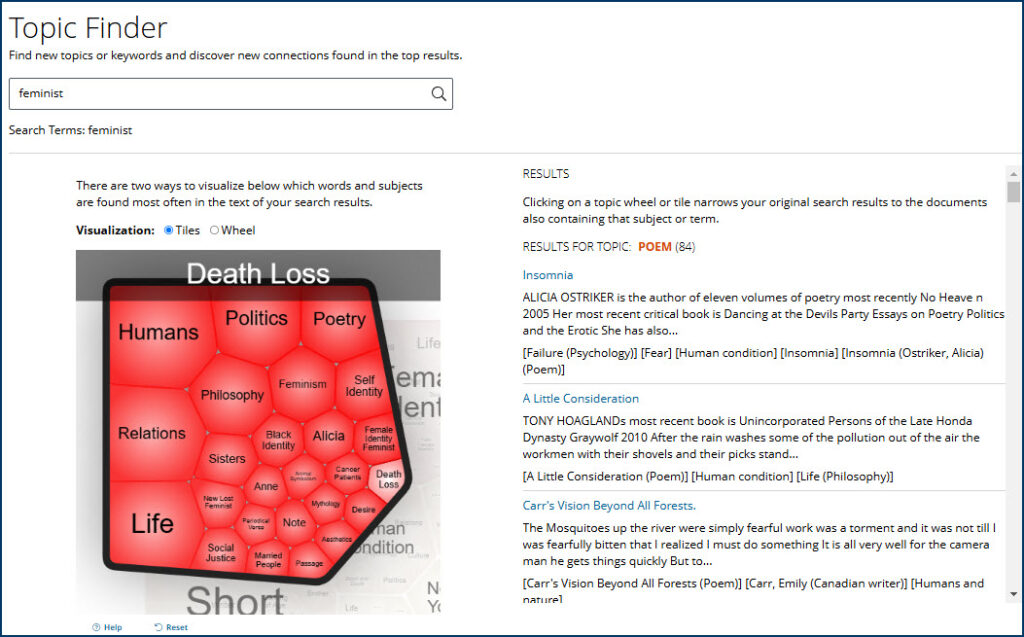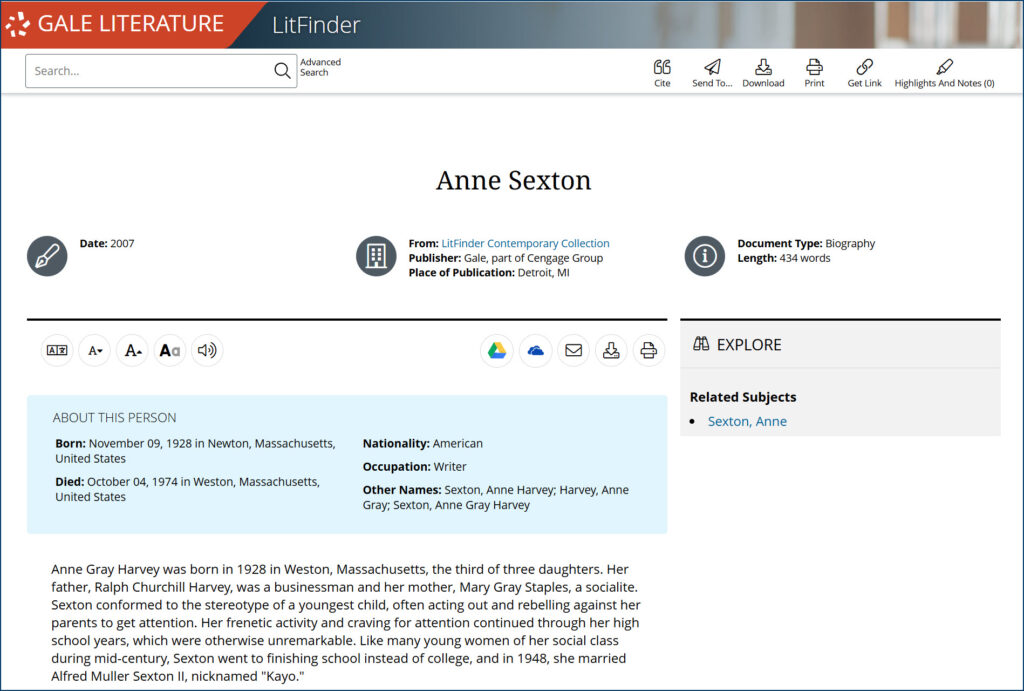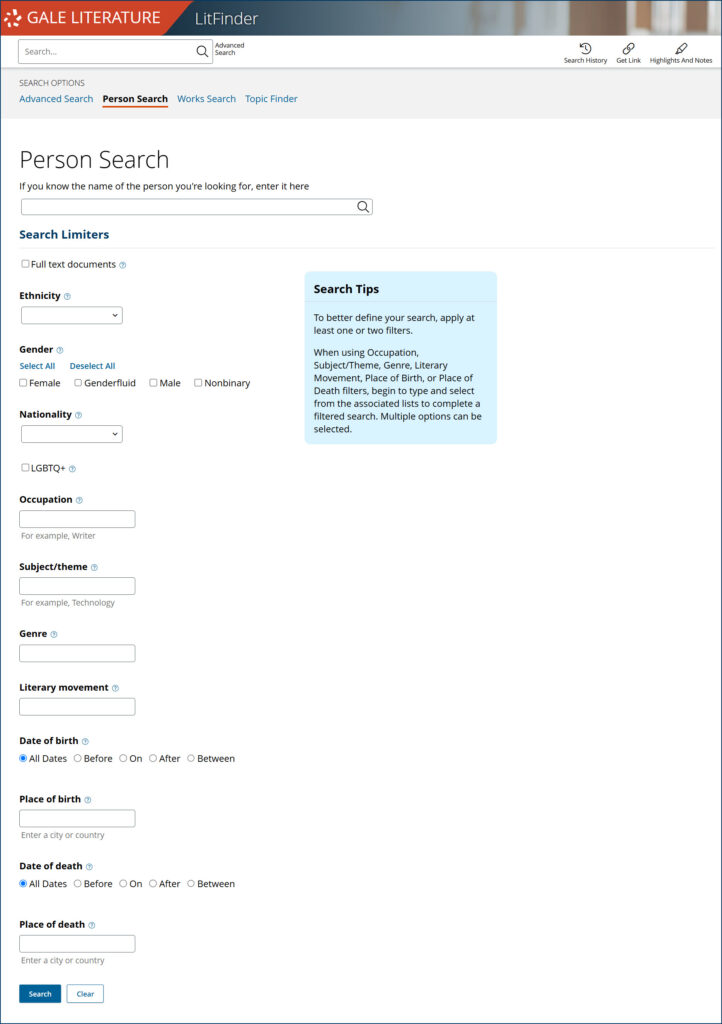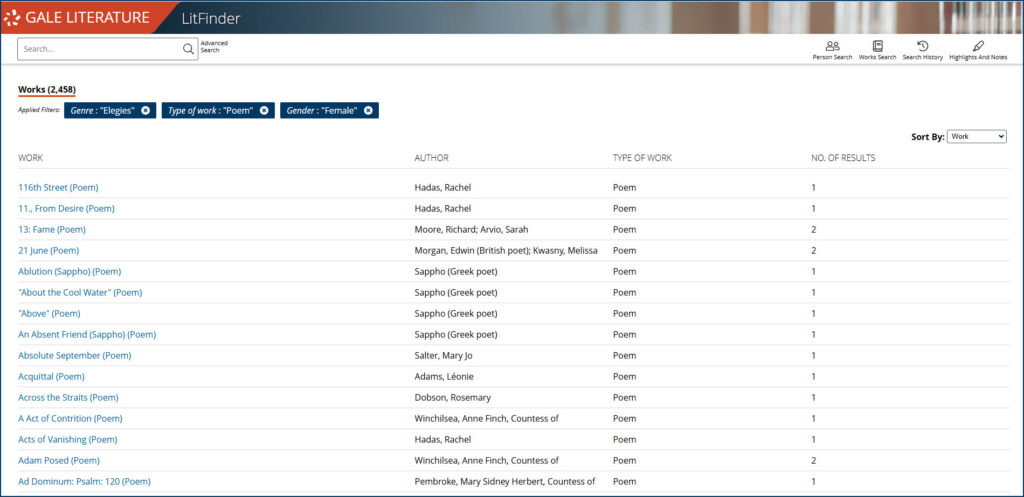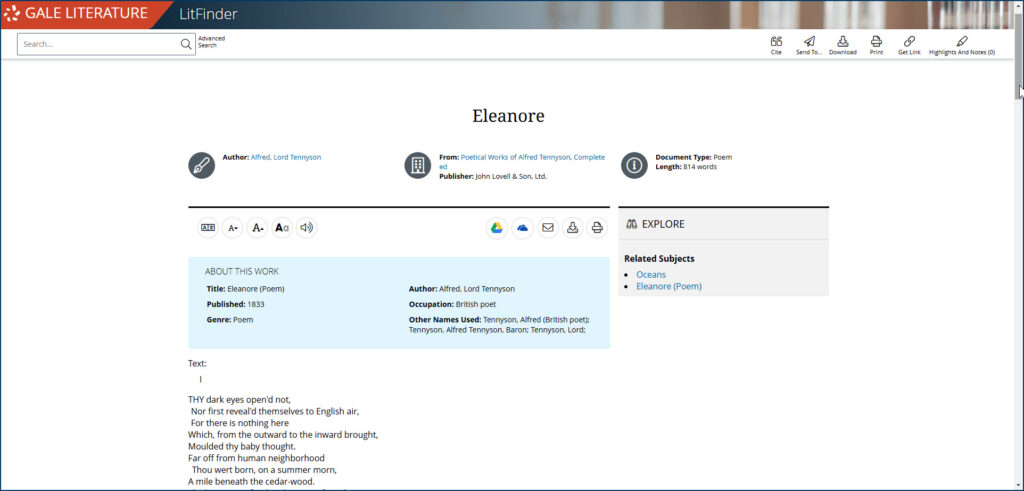| By Gale Staff |
Filipino writer F. Sionil José once remarked, “Poetry is emotion, passion, love, grief—everything that is human. It is not for zombies by zombies.”
Poetry captures the full range of human experience, but studying its deeper layers—historical milieu, cultural influences, and linguistic choices—requires the right set of tools.
Established in 1996 by the Academy of American Poets, National Poetry Month occurs every April and is dedicated to recognizing the importance of this literary form. For university faculty and students, it provides the perfect opportunity to engage with poetry in a scholarly context, and Gale Literature: LitFinder offers the resources to do just that.
This authoritative archive spans centuries, including more than 130,000 full-text poems, nearly 700,000 poetry citations and excerpts, and an extensive collection of biographies and critical essays empowering advanced literary research.
With this wealth of poetic texts and supporting materials, you can explore works from diverse traditions and time periods while refining broad inquiries into focused research questions with powerful search tools.
Let’s take a look at this extensive archive and its advanced search capabilities to demonstrate how researchers can move beyond the surface level in favor of sophisticated analyses.
Search Smarter: Advanced Tools for In-Depth Research
Poetic expression is a product of the moment it was written, shaped by the poet’s lived reality, the literary traditions they inherit or react against, and the historical forces at play around them.
A poet’s influences and links to other writers may not be obvious at first glance, however. Gale Literature: LitFinder includes powerful search tools including Person Search, Work Search, and Topic Finder, helping discover new connections and insight across time periods and traditions.
Let’s look at how these three tools can deepen a user’s understanding of a work.
Topic Finder: Visual Tools to Spark New Insights
Literary research often begins with broad areas of interest and open-ended questions in need of refinement. Young academics and seasoned faculty alike can benefit from Gale Literature: LitFinder’s ability to provide guidance in narrowing research queries to map previously uncharted connections.
For example, Topic Finder organizes expansive literary themes into interactive, data-driven visualizations. Instead of sifting through long lists of search results, researchers can explore clusters of related concepts that reveal thematic intersections they might not have initially considered.
A researcher curious about how poets engage with mourning across feminist traditions might start with the term “feminist” in Topic Finder, which generates an interactive display of broad, related topics—including poetry. Clicking on this sub-topic reveals further categories, such as self-identity, social justice, aesthetics, animal symbolism, black identity, desire, and death/loss.
Clicking on “death/loss” reveals a list of documents that contain all the previously selected keywords—feminist, poetry, and death/loss—allowing the researcher to see how poets have delved into mortality through a feminist lens.
One of the poets listed in the results is Anne Sexton, a mid-20th-century American confessional poet whose works speak on themes like grief and existential struggle. Digging further into her works offers an abstract for her posthumously published poem “The Truth the Dead Know.” From there, you can easily access the full text of the poem from a trusted source—in this instance, the Academy of American Poets. At the same time, Gale provides the in-depth context needed for proper analysis, including Sexton’s biography and an examination of the poem as a response to her parents’ deaths.
Unlike traditional elegies that emphasize remembrance and reverence, Sexton’s poem conveys detachment, using sparse, cutting language.
“Gone, I say and walk from church, / refusing the stiff procession to the grave, / letting the dead ride alone in the hearse. / It is June. I am tired of being brave.”
This thematic departure from convention makes “The Truth the Dead Know” a compelling example of poetic mourning, eschewing sentimentality in the wake of the loss of someone with whom she shared a tempestuous relationship. Because LitFinder’s biographical and critical resources provide this context, researchers can better assess Sexton’s treatment of loss and how it diverges from both traditional and contemporary perspectives.
Person Search: The Voices Behind the Verses
Poetry has long been a medium for feminist discourse, but its expressions are as varied and nuanced as the lived experiences of the writers themselves. Feminist poets approach their craft from different intersections of identity—race, class, nationality, sexual identity, etc.—resulting in distinct poetic traditions that overlap and deviate.
Researchers examining feminist elegies might begin with Anne Sexton’s work, and then broaden their understanding of how different poets approach grief. By turning to LitFinder’s Person Search, they can refine their inquiry by selecting “African American” as the ethnicity, “death” as the subject/theme, and “poetry” as the genre. This search generates a list of 32 poets whose works engage with themes of loss and remembrance.
Among them is Gwendolyn Bennett, a Harlem Renaissance poet who passionately advocated for cultural education and the responsibility of preserving black literary voices. Bennett’s “Lines Written at the Grave of Alexander Dumas” is an elegy that reflects on literary immortality and artistic works as a cultural inheritance.
“Oh, stir the lucid waters of thy sleep / And coin for me a tale / Of happy loves and gems and joyous limbs / And hearts where love is sweet! / A cemetery is a place for broken hearts / And silent thought . . . . / And silence never moves, / Nor speaks nor sings.”
Unlike personal elegies that mourn an individual’s passing, Bennett’s poem is an act of literary preservation. As she exhorts Dumas—a black author of Haitian descent—to continue telling stories, she further reminds the living of their duty to uphold his legacy of “happy loves and gems and joyous limbs.”
Researchers can then dig into linked resources to learn how Bennett’s work connects to the larger efforts of reclaiming and celebrating black artistic contributions during the Harlem Renaissance.
Works Search: Tracing the Evolution of Poetic Form and Function
Having explored how Sexton’s elegy defies convention and how Bennett’s work turns mourning into an act of literary preservation, researchers might be curious to understand how women have adapted the elegiac form as an expression of grief across time.
Turning to Works Search, you can refine the inquiry by filtering for “poems,” “elegies,” and “female” poets. This leads them to Sappho, one of the earliest recorded poets whose work, though fragmented, has shaped centuries of poetic tradition.
Sappho’s elegiac style bridges the personal and the historical, combining Sexton’s introspective lyricism with Bennett’s reckoning with legacy. She strips away personal grief to meditate on the finality of death and the absence of remembrance. In one of her surviving fragments, “From Sappho,” she wrote:
“Thou liest dead—lie on: of thee / No sweet remembrances shall be, / Who never plucked Pierian rose, / Who never chanced on Anteros.”
On the “From Sappho” page, users will find a list of relevant themes such as death, love, erotic love, and Greek poetry on LitFinder’s Explore sidebar, which takes them to related primary sources and literary works. To trace Sappho’s enduring influence through LitFinder’s collection of commentary and critical analysis, researchers might return to the Works Search results.
For example, the Romantic poet Percy Bysshe Shelley drew on her expressive intensity, evident in works like “To — (1). [I fear thy kisses, gentle maiden]” (1821). Similarly, Lord Tennyson was inspired by Sappho’s Fragment 31 in his poem “Eleänore” (1833).
Her influence extends into modern feminist and queer elegiac poetry as well, through writers like H.D. (Hilda Doolittle) in “Holy Satyr” (1925) and Audre Lorde in “Sisters in Arms” (1986), both of whom reimagine Sapphic themes of desire and grief with contemporary perspectives on identity.
By following this path, you can uncover a lineage of feminist elegy shaped by personal, historical, and philosophical frameworks. From Sexton’s raw, self-destructive grief to Bennett’s cultural homage to Sappho’s stark meditation on death, LitFinder gives researchers new paths to understand ineffably human topics from a variety of different perspectives.
Engage Your Campus in National Poetry Month
To help you share advanced search capabilities with the campus community, Gale offers librarians a suite of promotional tools—including digital banners, curated activities, and social media content—to showcase LitFinder’s potential as a gateway to academic inquiry.
Librarians can integrate web banners with National Poetry Month messaging across research guides, campus newsletters, and library websites and set up direct links to the LitFinder platform. There are also ready-to-use social media posts featuring poem excerpts from Emily Dickinson, Robert Frost, William Shakespeare, and Elizabeth Barrett Browning.
For libraries seeking to encourage active participation, the Poets Corner Scavenger Hunt provides an interactive framework for students to explore LitFinder, sharpening their research skills while drawing connections between poets and evolving poetic forms.
Access Gale’s All-in-One Poetry Platform
From examining the evolution of poetic forms to amplifying the voices of historically marginalized poets, Gale Literature: LitFinder makes studying poetry a rigorous and multidimensional scholarly pursuit.
If you would like more information about how to add LitFinder to your suite of Gale research tools, reach out to your Gale sales rep to learn more about the database and request a free trial.


